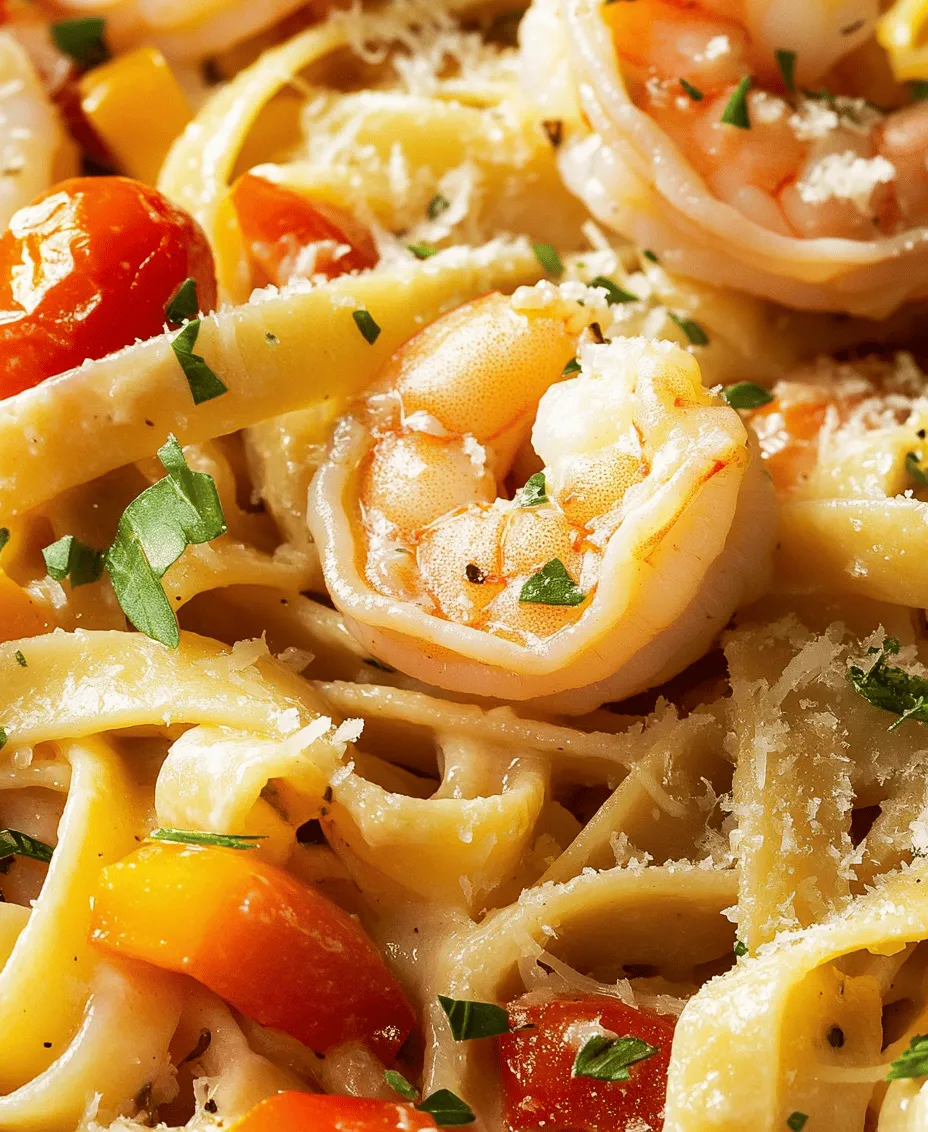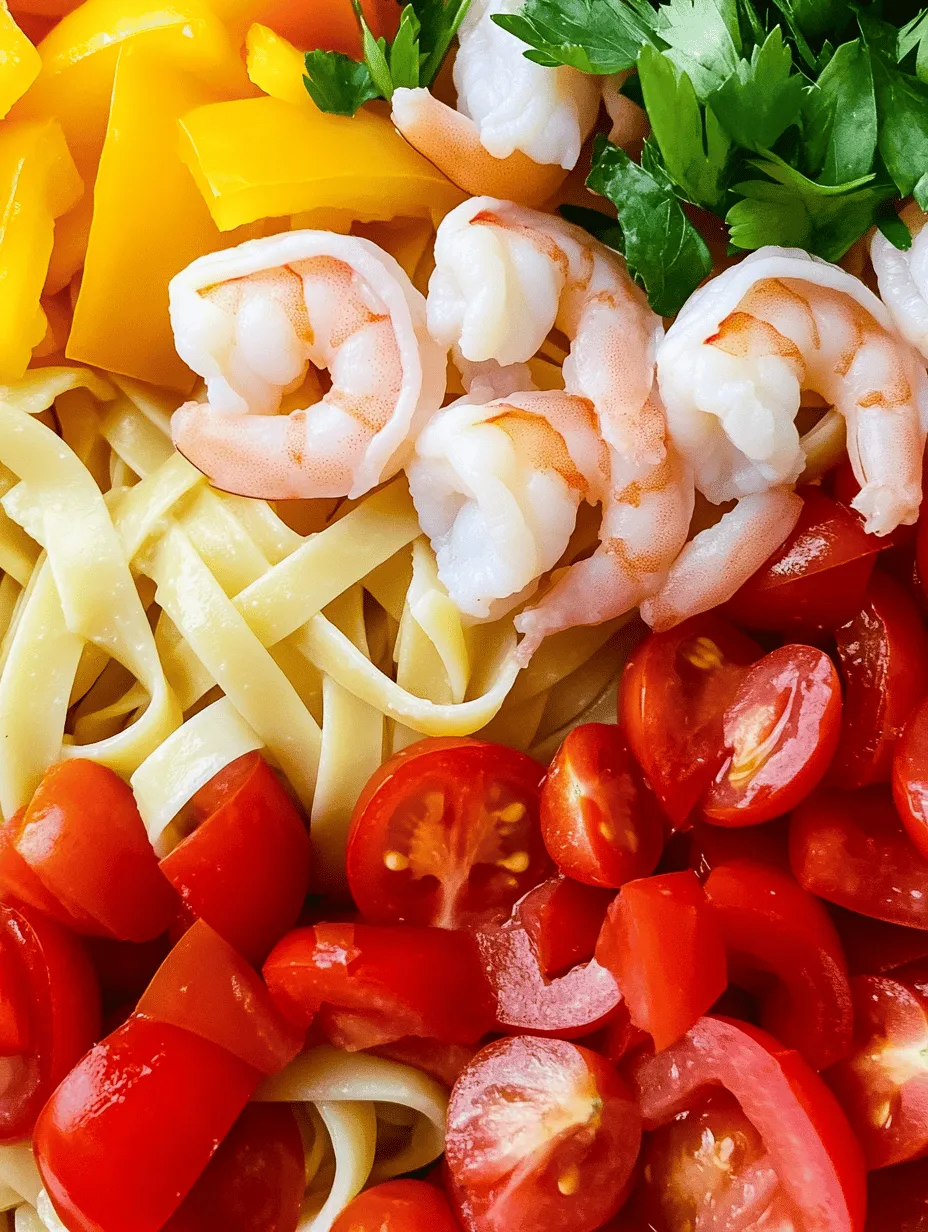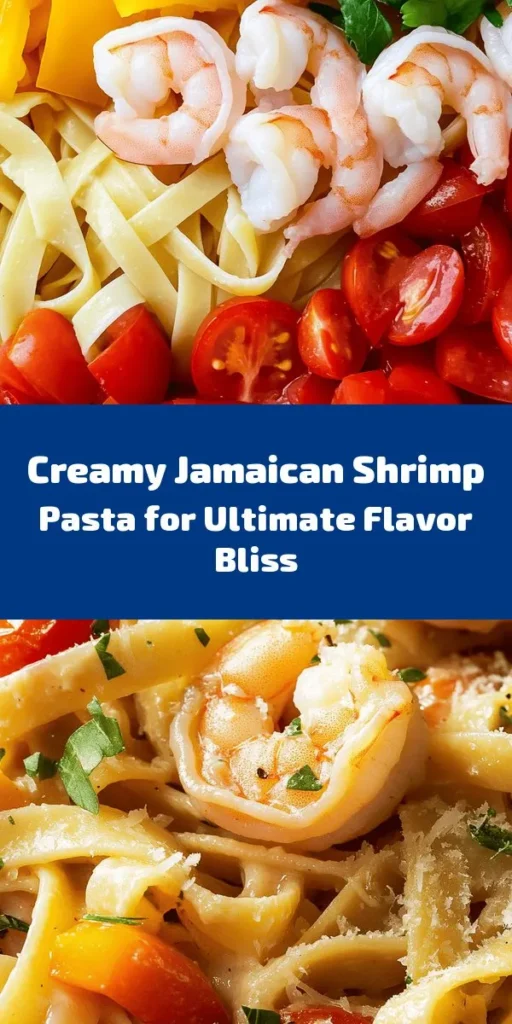Introduction
Jamaican cuisine is a vibrant tapestry of flavors, colors, and aromas that reflect the island’s rich cultural heritage. Known for its bold spices and fresh ingredients, Jamaican food offers a delightful culinary experience that is both comforting and exciting. Among the many gastronomic delights from Jamaica, one dish that stands out for its fusion of Caribbean and Italian influences is Jamaican Shrimp Pasta. This unique dish marries the traditional elements of pasta with the lively, aromatic spices typical of Jamaican cuisine, creating a meal that is not only delicious but also visually appealing.
In the world of home cooking, having easy-to-follow recipes is essential for making dishes that impress family and friends without overwhelming the cook. Jamaican Shrimp Pasta fits this bill perfectly, offering a straightforward yet flavorful approach to weeknight dinners, special occasions, or even a casual gathering. With its creamy sauce and succulent shrimp, this dish is sure to become a favorite in your culinary repertoire.
The Allure of Jamaican Shrimp Pasta
What makes Jamaican Shrimp Pasta truly special is its unique flavor profile. The creaminess of the sauce blends seamlessly with the spices, creating a rich, satisfying dish that is both indulgent and refreshing. The combination of coconut milk and heavy cream forms the foundation of the sauce, delivering a silky texture that coats each strand of pasta beautifully. This creaminess is balanced by the warmth of spices like thyme, allspice, and cayenne, which add depth and character to the dish.
Seafood plays a pivotal role in Caribbean cuisine, and shrimp, in particular, is a star ingredient. Known for their sweet, delicate flavor and tender texture, fresh shrimp elevate this dish to new heights. When cooked just right, shrimp can add a burst of flavor that complements the creamy sauce, making every bite a delightful experience.
One of the appealing aspects of Jamaican Shrimp Pasta is its versatility. Whether you’re hosting a formal dinner party or enjoying a cozy night in, this dish can adapt to suit any occasion. It pairs wonderfully with a crisp salad or garlic bread, and can easily be dressed up with fresh herbs or a splash of lime juice for added brightness. This adaptability makes Jamaican Shrimp Pasta a go-to recipe for any home cook looking to impress.
Ingredients Breakdown
To create a delicious Jamaican Shrimp Pasta, it is crucial to understand the role of each ingredient in the dish. The following breakdown highlights the main components that come together to create this creamy delight.
Fettuccine or Linguine: Choosing the Right Pasta for Texture
The choice of pasta is fundamental to the overall texture of the dish. Fettuccine and linguine are both excellent options, with fettuccine offering a broader surface area for the sauce to cling to, while linguine provides a slightly lighter bite. Whichever pasta you choose, ensure it is cooked to al dente perfection to provide a pleasant chewiness that complements the creaminess of the sauce.
Shrimp: Importance of Using Fresh, High-Quality Shrimp
When it comes to shrimp, freshness is key. Opt for high-quality, deveined shrimp for the best results. Fresh shrimp not only taste better but also have a firmer texture, which is essential for this dish. If using frozen shrimp, be sure to thaw them properly and pat them dry before cooking to avoid excess moisture that can dilute the sauce.
Coconut Oil: The Flavor and Health Benefits
Coconut oil is a staple in Jamaican cooking, and for good reason. It imparts a subtle coconut flavor that enhances the overall taste of the dish while providing healthy fats. Using coconut oil in place of traditional cooking oils not only aligns with the dish’s Caribbean roots but also adds a healthful twist to your pasta.
Aromatic Vegetables: Role of Onion, Garlic, and Bell Pepper
Aromatics are crucial for building the flavor base of any dish, and Jamaican Shrimp Pasta is no exception. Onions, garlic, and bell peppers work together to create a fragrant foundation. Sautéing these vegetables releases their natural sweetness and enhances the dish’s overall flavor profile. The colors of the bell peppers also add visual appeal, making the final dish more inviting.
Seasonings: Exploring Thyme, Allspice, and Cayenne for Authentic Flavor
The right seasonings can elevate a dish from ordinary to extraordinary. In this recipe, thyme, allspice, and cayenne pepper play essential roles in achieving an authentic Jamaican flavor. Thyme, which is commonly used in Caribbean cooking, adds an earthy aroma, while allspice contributes a warm, spicy note. A touch of cayenne provides a gentle heat that balances the creaminess of the sauce.
Coconut Milk and Heavy Cream: The Foundation of the Creamy Sauce
The combination of coconut milk and heavy cream is what makes this sauce irresistibly creamy. Coconut milk offers a rich, tropical note that pairs beautifully with the shrimp and spices, while heavy cream adds an indulgent texture. Together, they create a luscious sauce that envelops the pasta and shrimp, making each bite decadent.
Cherry Tomatoes: Adding Freshness and a Pop of Color
To round out the dish, cherry tomatoes provide a burst of freshness and a pop of color. Their natural sweetness complements the savory elements of the sauce, and they add a delightful juiciness that contrasts with the creaminess of the pasta. Halve the cherry tomatoes before adding them to the dish to ensure that their flavor melds perfectly with the other ingredients.
Step-by-Step Cooking Instructions
Now that we’ve explored the enticing flavors and ingredients of Jamaican Shrimp Pasta, it’s time to dive into the cooking process. Follow these detailed steps to create a delicious meal that will leave everyone asking for seconds.
Cooking the Pasta: Tips for Achieving Al Dente Perfection
1. Boil Water: Start by bringing a large pot of salted water to a rolling boil. The salt enhances the pasta’s flavor, so don’t skip this step.
2. Cook the Pasta: Add your choice of fettuccine or linguine to the boiling water and cook according to the package instructions until al dente. Al dente means the pasta should be firm to the bite but not hard.
3. Reserve Pasta Water: Before draining the pasta, reserve about a cup of the starchy cooking water. This liquid is essential for adjusting the consistency of your sauce later.
4. Drain and Set Aside: Drain the pasta and set it aside while you prepare the sauce. Avoid rinsing the pasta, as this will wash away the starch that helps the sauce adhere.
Sautéing Shrimp: Importance of Not Overcooking for Optimal Texture
1. Heat Coconut Oil: In a large skillet, heat a tablespoon of coconut oil over medium-high heat. Allow the oil to get hot but not smoking, as this can burn the shrimp.
2. Add Shrimp: Once the oil is shimmering, add the fresh shrimp to the skillet in a single layer. Avoid overcrowding the pan, as this can lead to steaming rather than sautéing.
3. Season and Cook: Season the shrimp with salt and pepper, and sauté for about 2-3 minutes on each side, or until they turn pink and opaque. Be careful not to overcook the shrimp, as they can become rubbery. Remove the cooked shrimp from the skillet and set them aside.
Sautéing Vegetables: Unlocking Flavors Through Proper Cooking Techniques
1. Add Aromatics: In the same skillet, add another tablespoon of coconut oil if needed. Once hot, add chopped onions and sauté for 2-3 minutes until they are soft and translucent.
2. Incorporate Garlic and Bell Peppers: Next, add minced garlic and diced bell peppers to the skillet. Sauté for an additional 2-3 minutes, allowing the vegetables to soften and the garlic to become fragrant.
3. Season the Vegetables: Sprinkle in the thyme, allspice, and cayenne pepper, stirring well to coat the vegetables in the spices. This step will develop the flavors further, creating a tantalizing base for the sauce.
With these initial steps, you have set the stage for building a rich and creamy sauce that will envelop your pasta and shrimp. As you continue with the recipe, you’ll see how these flavors meld together to create an unforgettable dish that showcases the best of Jamaican and Italian culinary traditions.

Seasoning the Dish: Balancing Spices for a Flavorful Outcome
Seasoning is a crucial step in crafting a delicious Jamaican Shrimp Pasta. The right balance of spices not only enhances the natural flavors of the shrimp but also complements the creamy sauce. Start by seasoning the shrimp with a mix of salt, black pepper, and a dash of cayenne for heat. This combination will bring out the sweetness of the shrimp while adding a subtle kick.
For a distinctly Jamaican flavor, incorporate traditional spices such as allspice and thyme. Allspice, with its warm, aromatic notes, pairs beautifully with shrimp, while thyme adds a fresh herbal quality. Mix these spices directly with the shrimp and allow them to marinate for about 15-20 minutes before cooking. This marination allows the flavors to penetrate the shrimp, resulting in a more flavorful dish.
As you prepare the sauce, consider adding garlic and onion for depth. Sauté diced onions and minced garlic in coconut oil until they are soft and fragrant. This foundation sets the stage for adding the other ingredients, infusing the entire dish with rich flavors.
Creating the Sauce: Techniques for Achieving the Right Consistency
To create a creamy sauce that clings perfectly to both the shrimp and pasta, start with a base of coconut milk. This ingredient not only adds creaminess but also introduces a subtle sweetness that complements the spices. Heat the coconut milk in a saucepan over medium heat, stirring frequently to prevent it from scorching.
Next, add in your sautéed onions and garlic, followed by diced tomatoes for acidity and freshness. Allow the sauce to simmer gently, letting the flavors meld together. If the sauce appears too thick, you can thin it out with a splash of pasta cooking water or vegetable broth, adjusting until you achieve a velvety consistency.
To enrich the sauce further, stir in grated Parmesan cheese or nutritional yeast for a dairy-free alternative. This addition not only enhances the creaminess but also provides a savory depth. For a hint of acidity, a squeeze of lime or lemon juice just before serving brightens the flavors, making the dish more vibrant.
Combining Elements: Tips for Ensuring Even Coating of Pasta and Shrimp
Once your pasta is cooked al dente and your sauce is ready, it’s time to combine the elements. Begin by adding the cooked pasta directly to the sauce in the pan. This method allows the pasta to absorb some of the sauce while ensuring an even coating. Use tongs or a pasta fork to gently toss and mix the pasta with the sauce, ensuring every noodle is well-coated.
Next, fold in the seasoned shrimp. If you’ve sautéed the shrimp separately, add them to the pasta mixture and allow them to heat through for a few minutes. This step is crucial as it ensures that the shrimp retains its juicy texture without overcooking.
For an added layer of flavor, consider sprinkling in chopped fresh parsley or green onions at this stage. These fresh herbs not only enhance the flavor but also add a pop of color to your dish, making it visually appealing.
Final Touches: Importance of Seasoning and Garnishing for Presentation
As you prepare to serve your Jamaican Shrimp Pasta, take a moment to taste and adjust the seasoning. This final check is essential, as it allows you to balance the flavors perfectly. If the dish tastes flat, a pinch of salt or a dash of hot sauce can elevate the overall flavor profile.
For garnishing, a sprinkle of freshly chopped herbs, such as cilantro or parsley, adds a burst of color and freshness. A few slices of lime on the side not only enhance the presentation but also offer an extra zing of flavor for those who like it tangy.
When plating, consider the visual appeal. Twirl the pasta in the center of the plate, artfully placing the shrimp on top. Drizzle some extra coconut cream or a light olive oil around the edges for a polished look.
Nutritional Information
Jamaican Shrimp Pasta is not just a feast for the senses; it also delivers a range of nutritional benefits. The primary ingredient, shrimp, is an excellent source of protein. A typical serving of shrimp contains about 24 grams of protein, making it a great choice for muscle repair and overall health.
The use of coconut oil and cream provides healthy fats that are beneficial for heart health. These fats can help improve cholesterol levels, making your meal more nutritious. Additionally, the dish includes a variety of vegetables such as onions and tomatoes, which are packed with vitamins and minerals. Onions offer anti-inflammatory properties, while tomatoes are rich in antioxidants like lycopene.
When considering portion sizes, it’s essential to create a balanced meal. A serving of Jamaican Shrimp Pasta should be complemented with a side salad or steamed vegetables to ensure a well-rounded diet. This balance not only supports health but also helps in managing calorie intake.
Serving Suggestions
To elevate your dining experience, consider ideal pairings for Jamaican Shrimp Pasta. A crisp green salad dressed with a light vinaigrette can provide a refreshing contrast to the creamy pasta. For a more Caribbean twist, a mango salsa can add sweetness and acidity that complements the dish beautifully.
When it comes to beverages, a chilled white wine like Sauvignon Blanc or Pinot Grigio pairs wonderfully with the shrimp and creamy sauce. For non-alcoholic options, a refreshing lemonade or a coconut water spritzer can enhance the tropical vibes of the meal.
If you have leftovers, storing them properly is key to maintaining flavor and texture. Place any remaining pasta in an airtight container and refrigerate for up to three days. When reheating, add a splash of coconut milk or broth to restore creaminess, and heat gently on the stovetop to avoid overcooking the shrimp.
Cultural Significance of the Dish
Jamaican Shrimp Pasta represents a fusion of culinary traditions, showcasing the rich history of shrimp in Jamaican cuisine. Shrimp have long been a staple in Caribbean cooking, often found in dishes like curry shrimp and shrimp fritters. The use of fresh seafood is deeply rooted in the island’s culture, reflecting its coastal geography and abundant marine life.
The combination of Italian pasta with Jamaican flavors illustrates the global influences that shape our culinary landscape. This dish embodies the beauty of cultural exchange, where ingredients and techniques from different cuisines come together to create something unique and delicious.
Moreover, food holds a significant place in Jamaican culture, with communal meals often serving as a means to strengthen family ties and friendships. Sharing a dish like Jamaican Shrimp Pasta at gatherings fosters connection and creates lasting memories, making it not just a meal, but a celebration of life and togetherness.
Conclusion
Making Jamaican Shrimp Pasta is not just about preparing a meal; it’s about experiencing the joy of cooking and exploring the rich tapestry of flavors that different cultures offer. The creamy sauce combined with the tender shrimp and perfectly cooked pasta creates a satisfying dish that caters to both the palate and the soul.
As you explore this recipe, don’t hesitate to make it your own. Experiment with spices, adjust the creaminess to your liking, or even add your favorite vegetables. The beauty of cooking lies in the freedom to create and adapt, allowing you to connect with various culinary traditions.
In conclusion, Jamaican Shrimp Pasta is not only a delicious dish but also a gateway to understanding and appreciating the diverse world of flavors. So grab your ingredients, gather your loved ones, and embark on a culinary adventure that celebrates the art of cooking and the joy of sharing meals.



